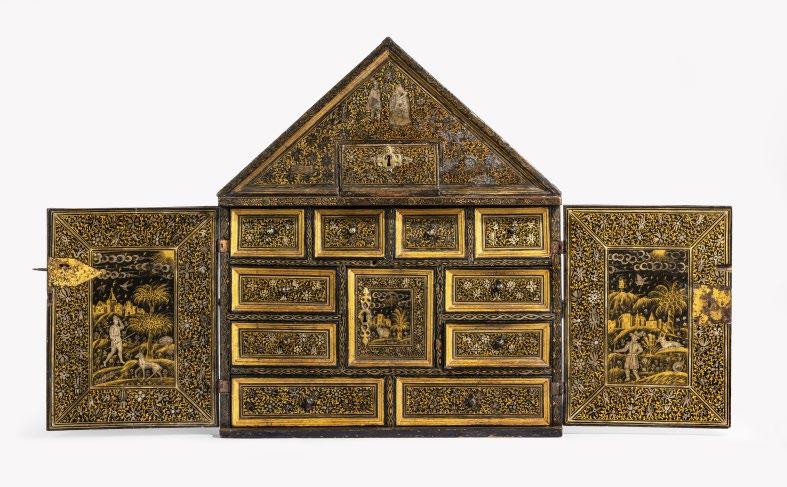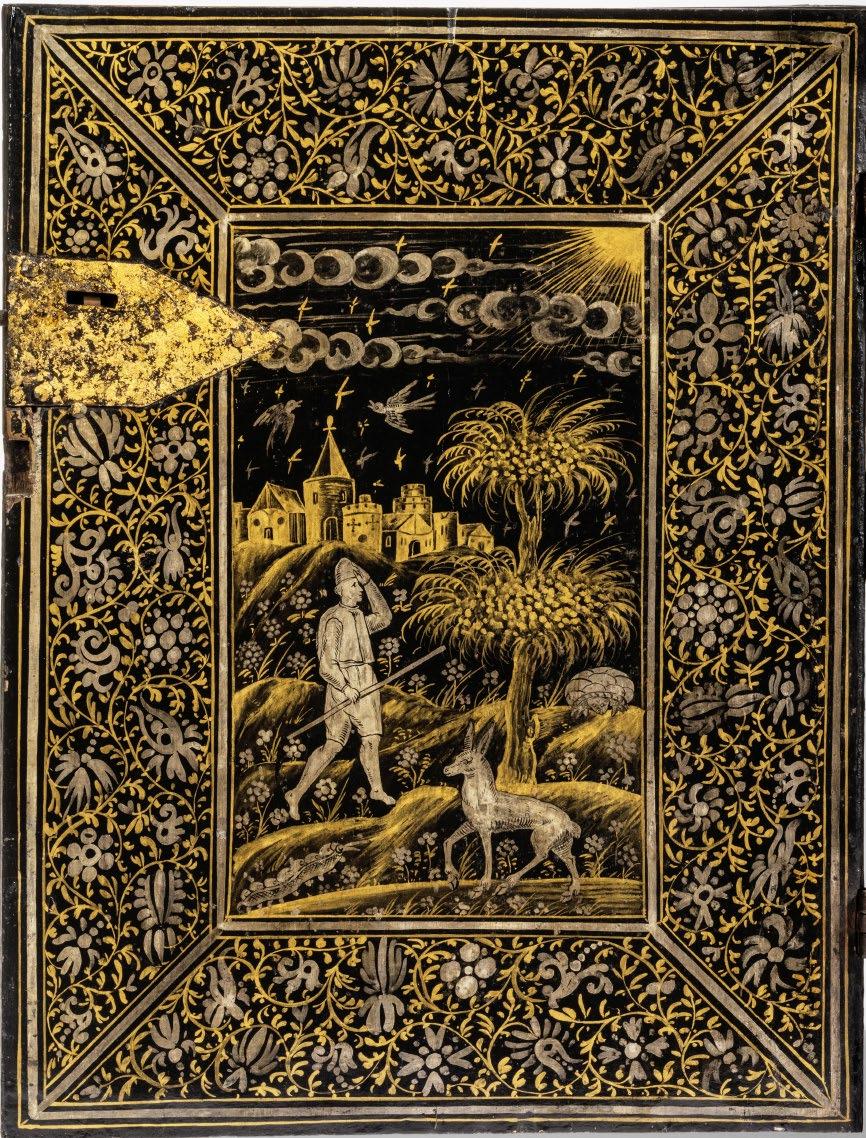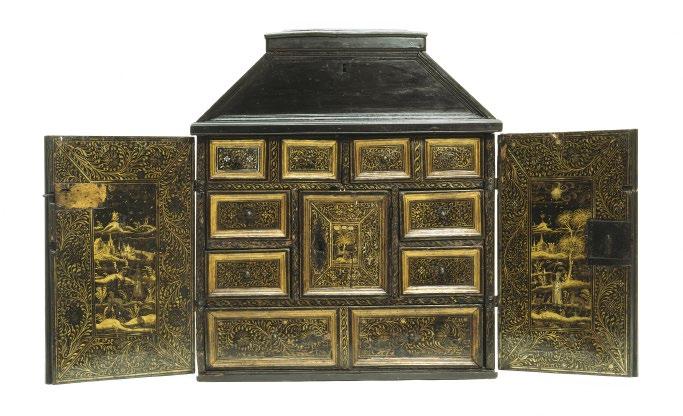
3 minute read
A rare ‘Japanned’ table cabinet
54 A rare English ‘Japanned’ table cabinet, circa 1624
Height: 29½in (75cm) Width: 22½in (57cm) Depth: 12in (30.5cm)
Advertisement
This oak cabinet is of rectangular form surmounted by a triangular pediment enclosing a small central drawer, above two doors which open to reveal four short and six longer drawers arranged around a central cupboard. The whole, as described by the Victoria and Albert Museum, London, is painted black and ‘mordant gilded, silvered and varnished’ with landscapes and figures within wide borders profusely painted with scrolling vegetation. The principal panels on the doors, top and sides, show Dutch figures and animals of the hunt in landscapes set before fortified towns with mountainous landscapes behind, all beneath a sky of stylized cloud scrolls, the interior of the drawers painted red. There are five secret compartments hidden behind the upper drawers and within the triangular pediment. Provenance: A private collection Literature: Victor Chinnery, ‘Oak Furniture: The British Tradition’ Figs. 2.238 & 2.238a Directly related cabinets which have been used to authenticate and date the present cabinet are in the following collections: Victoria & Albert Museum, London W.9-1936, English circa1620 (see page 56) Leeds Museums & Galleries; Temple Newsam, no.1971.00 34 dated 1620
National Gallery of Victoria, Melbourne, Australia, V&A, W.37-1927 c1620
Private Collection, shown at the Stuart Legacy Exhibition, Birmingham Museum of Art, Alabama USA, Private Collection ex John Fardon Collection, sold Christies South Kensington 06/07/1994, lot 337 and again CSK 01/05/1996, lot 300. Ballot Box dated 1619 made for the East India Company now in the collection of The Worshipful Company of Saddlers.

Articles in the Burlington Magazine in 1934 and 1936 show there was some debate regarding the origin of these cabinets. Firstly, Vilhelm Slomann averred that pieces related to the ballot box dated 1619, made for the Honourable East India Company now in the collection of The Worshipful Company of Saddlers, were of Indian manufacture only to be refuted by Ralph Edwards who claimed they were made in London. Likewise, Peter Thornton in 1972 writes that these table cabinets ‘constitute the earliest recorded manifestation of Chinoiserie taste in this country’. Indeed, both the Victorian and Albert Museum, London and the National Gallery of Victoria, Melbourne, catalogue their cabinets as English. The present cabinet has many obvious similarities to the rest of the group but the decoration of the figural panels definitely depicts Dutch figures and European landscapes and there is some attempt at perspective whereas the others also show turbaned Orientals, dragons and stylised landscapes reminiscent of Chinoiserie decorative schemes. In ‘Oak Furniture, The British Tradition’, Victor Chinnery gives an Anglo-Dutch attribution under the illustration of this cabinet but in the text on p120 he suggests that if a Dutchman did make this piece he could have done so in this county. As explained by Slomann the arabesque borders undoubtedly draw inspiration from Indian and Islamic sources. The most intriguing image is that of a lady and gentleman in the centre of the pediment – could they have commissioned the cabinet?

© Victoria and Albert Museum, London
Bibliography:
Burlington Magazine No 65 1934, (Vilhelm Slomann) ‘The Indian Period of European Furniture’, p.113-4. Burlington Magazine No 68 May 1936 (R. Edwards) ‘The Master of the Saddler’s Ballot Box’, p. 232-5. Burlington Magazine No 31 1917 (H. Clifford-Smith), pp.234-40. Cains, Carol and Matthew Martin, ‘A Cabinet of Curiosity: An Early English Japanned Cabinet in The Collection of the National Gallery of Victoria’ website. ‘Chinese Whispers, Chinoiserie in Britain’ Exhibition Catalogue, C2 Chinnery, Victor, ‘Oak Furniture: The British Tradition’, Figs. 2.238 & 2.238a Edwards, Ralph, ‘Dictionary of English Furniture’. p 162, figure 1. Gilbert, Christopher, ‘Furniture at Temple Newsam House & Lotherton Hall’. Leeds, 1978, Vol 1 p.47 no. 35 History of the Worshipful Company of Saddlers 2nd Volume, ‘Treasures & Plate’ Huth, Hans, ‘Lacquer of the West’, pl. 39, p.11 Irwin, J ‘Art & the East India Trade’, V& A 1970. Mercer, Eric ‘The Social History of the Decorative Arts – Furniture 700-1700’, figs. 175-6. Thornton, Peter, ‘English Cabinets,’ Victoria and Albert Museum, London 1972. Pls 1 & 2










